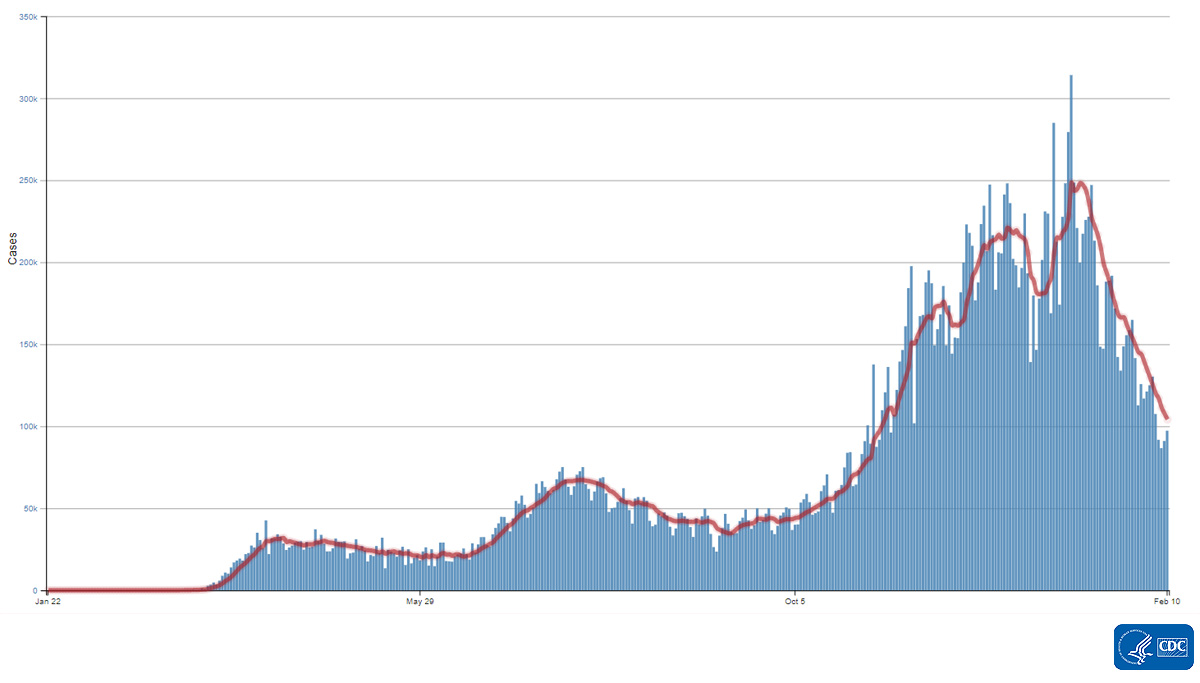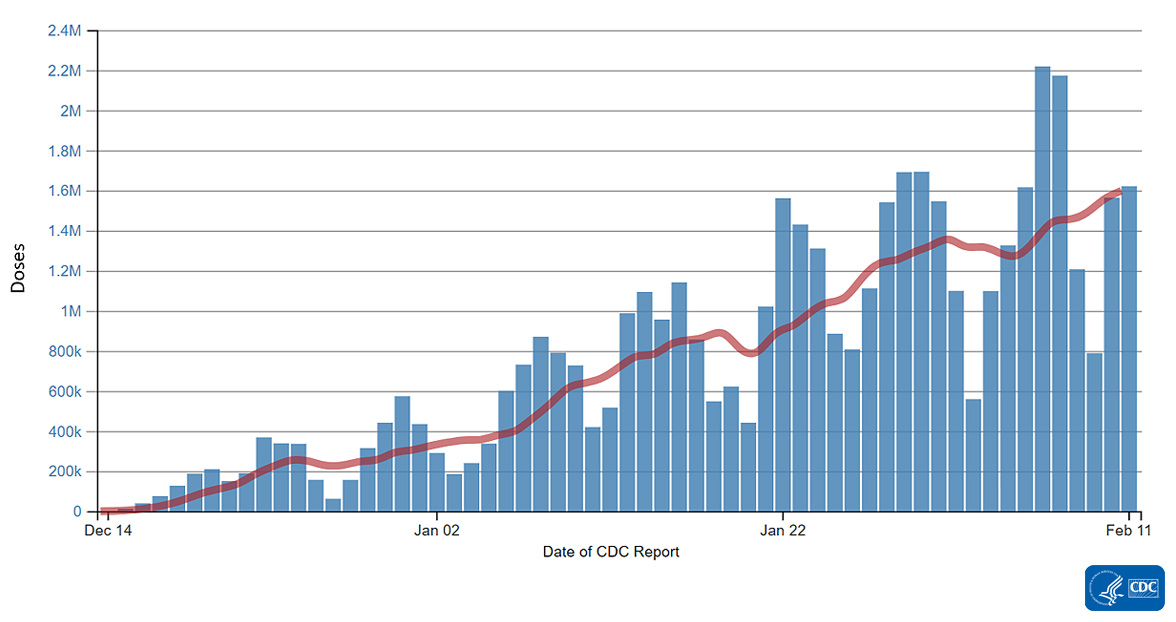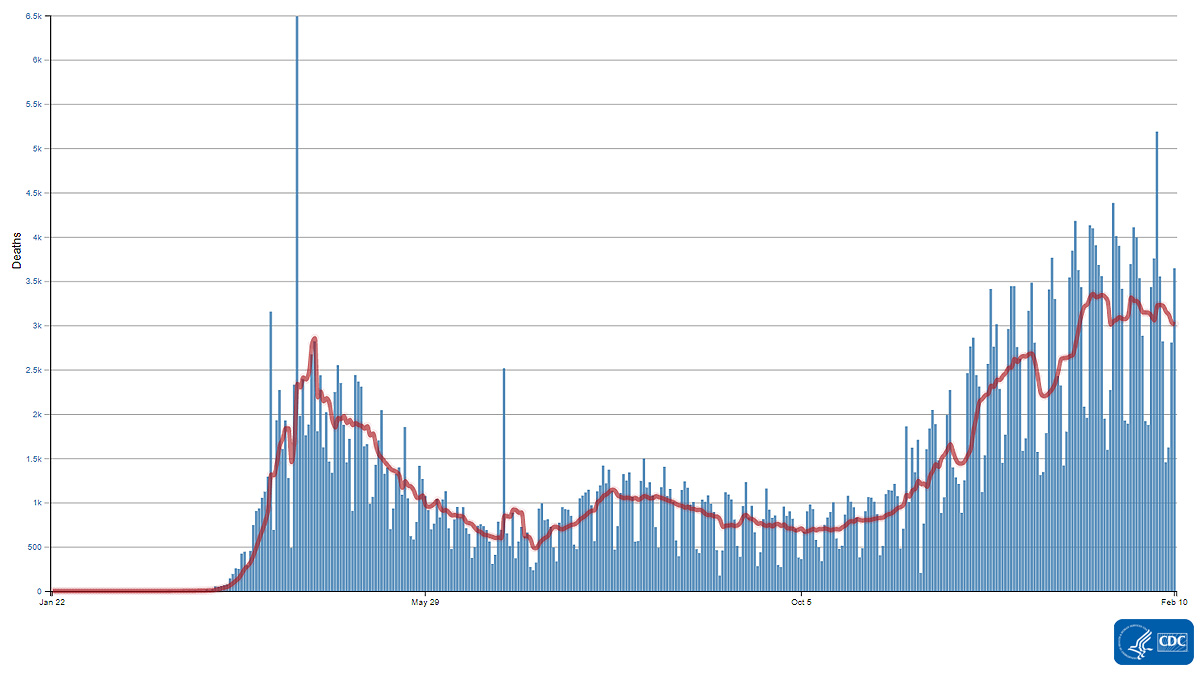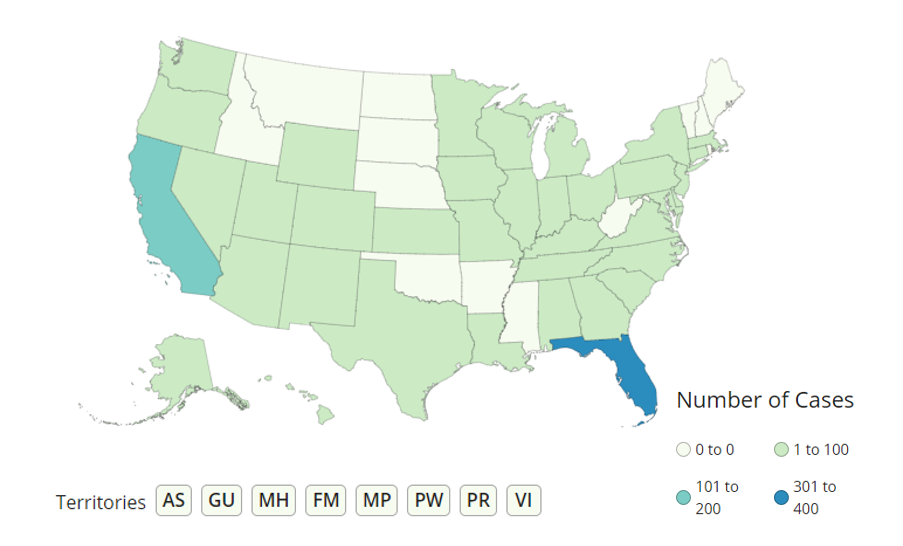Aquatics FAQs
Recommendations for Fully Vaccinated People
COVID-19 Homepage

Better, but Not Good Enough
Don’t let your guard (or mask) down. COVID-19 cases, hospitalizations, and deaths continue to trend downward. But even with that progress, the daily numbers of new cases and deaths remain much higher than the first two peaks of the pandemic in the spring and summer of 2020.
The COVID-19 pandemic has crossed the one-year mark. About 27 million cases and about 470,000 deaths have been reported to CDC since the first case was identified in the United States on January 20, 2020. The numbers of COVID-19 cases, hospitalizations, and deaths vary substantially below the national level, and to help explain these differences future versions of COVID Data Tracker Weekly Review will present surveillance trends at the regional, state, or county levels. A national milestone in vaccinations was reached this week on February 11 with about 34.7 million people receiving at least one dose of vaccine, which is 10.5% of the U.S. population. This is terrific progress.
CDC’s goal is to get the pandemic under control as quickly as possible, both to save lives and to help people get back to the many important things they need and want to do. The emergence of variants, such as B.1.1.7, reminds us that we all need to re-double our efforts to prevent the spread of COVID-19. It is more important than ever that we all wear well-fitting masks, stay at least 6 feet apart from people we don’t live with, avoid crowds and poorly ventilated spaces, and wash our hands often. These practices done well by all of us, together with the continued effort to vaccinate more people, can help end this pandemic.
Reported Cases
Compared with a national peak of 314,093 cases reported to CDC on January 8, 2021, the daily number of cases has declined by 69%. The current 23% decrease in the 7-day average number of daily cases reported also provides an encouraging sign of recent progress. Even with these declines, however, the 97,309 cases reported on February 11 remains higher than what was seen during either of the first two peaks in the pandemic.
97,309
New Cases Reported
97,309
New Cases Reported
104,217
Current 7-Day Average
104,217
Current 7-Day Average
27,127,858
Total Cases Reported
27,127,858
Total Cases Reported
134,524
Prior 7-Day Average
134,524
Prior 7-Day Average
314,093
High
314,093
High
-22.5%
Change in 7-Day Average
-22.5%
Change in 7-Day Average
Daily Trends in COVID-19 Cases in the United States Reported to CDC

7-Day moving average
Vaccinations
The U.S. COVID-19 Vaccination Program began December 14. As of February 11, 2021, 46.4 million vaccine doses have been administered. Overall, about 34.7 million people have received at least one dose of vaccine, which is 10.5% of the U.S. population, and about 11.2 million people have received two doses of vaccine, which is 3.4% of the U.S. population. As of February 11, the 7-day average number of administered vaccine doses reported to CDC per day was 1.6 million, which was a 24% acceleration from the previous week.
46,390,270
Vaccines Administered
46,390,270
Vaccines Administered
34,732,964
People who received 1 or more doses
34,732,964
People who received 1 or more doses
11,188,782
People who received 2 doses
11,188,782
People who received 2 doses
Daily Change in Number of COVID-19 Vaccinations in the United States Reported to CDC

7-Day moving average
New Hospital Admissions
The numbers of new hospital admissions of patients with confirmed COVID-19 have decreased from the national peak of 18,081 admissions on January 5, 2021 to 8,957 admissions on February 9 (a 50% decrease). The average number of daily admissions fell by 14% over the past week.
8,957
New Admissions
8,957
New Admissions
9,279
Current 7-Day Average
9,279
Current 7-Day Average
1,690,996
Total New Admissions
1,690,996
Total New Admissions
10,845
Prior 7-Day Average
10,845
Prior 7-Day Average
18,081
High
18,081
High
-14.4%
Change in 7-Day Average
-14.4%
Change in 7-Day Average
Daily Trends in Number of New COVID-19 Hospital Admissions in the United States Reported to CDC
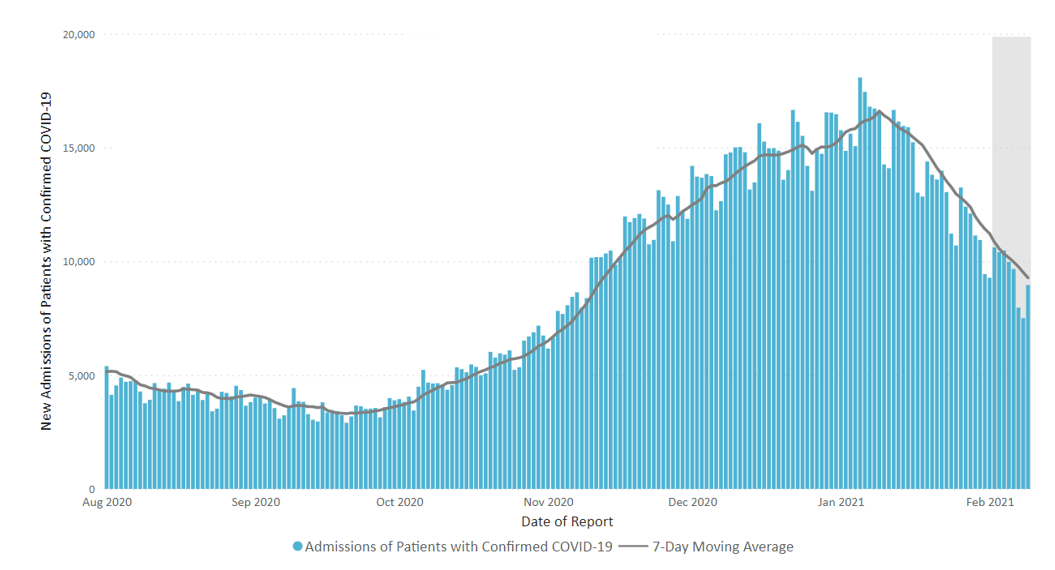
More data.external icon Data for most recent week are affected by incomplete reporting (grey shaded area).
Deaths
Nationally, the number of COVID-19 deaths peaked on February 4, 2021 at 5,189 deaths reported. Though the 3,645 deaths reported on February 11 is substantially lower (30% decrease), the current change in the 7-day average number of deaths was negligible (1.4% decrease). Daily mortality remains higher than in previous waves of the pandemic.
3,645
New Deaths Reported
3,645
New Deaths Reported
3,013
Current 7-Day Average
3,013
Current 7-Day Average
470,110
Total Deaths Reported
470,110
Total Deaths Reported
3,056
Prior 7-Day Average
3,056
Prior 7-Day Average
5,189
High
5,189
High
-1.4%
Change in 7-Day Average
-1.4%
Change in 7-Day Average
Daily Trends in Number of COVID-19 Deaths in the United States Reported to CDC

7-Day moving average
More Death DataSARS-CoV-2 Variants
Three SARS-CoV-2 (the virus that causes COVID-19) variants of concern have been detected in the United States: B.1.1.7, B.1.351, and P.1. A total of 981 B.1.1.7 variant cases have been detected in 37 states, which is a 61% increase in the number of B.1.1.7 cases reported by CDC compared with the previous week (611 cases). Thirteen cases with B.1.351 in five states and three cases with P.1 in two other states have also been detected in the United States. CDC and partners are increasing the numbers of specimens sequenced in laboratories around the country. Studies to determine whether variants cause more severe illness or are likely to evade immunity are underway. For technical description, see https://www.cdc.gov/coronavirus/2019-ncov/variants/index.html.
Variant
Variant
Variant
Reported Cases in US
Reported Cases in US
Reported Cases in US
Number of States with ≥1 Case Reported
Number of States with ≥1 Case Reported
Number of States with ≥1 Case Reported
B.1.1.7
Variant
B.1.1.7
981
Reported Cases in US
981
37
Number of States with ≥1 Case Reported
37
B.1.351
Variant
B.1.351
13
Reported Cases in US
13
5
Number of States with ≥1 Case Reported
5
P.1
Variant
P.1
3
Reported Cases in US
3
2
Number of States with ≥1 Case Reported
2
Note on new format: Effective Friday, February 12, 2021, COVIDView has been replaced with this new COVID Data Tracker Weekly Review. This new webpage and newsletter include key visuals from the week and narrative interpretations using data from CDC’s COVID Data Tracker. Additional priority data will be added in future weeks, including race and ethnicity.
The Coronavirus Disease 2019 (COVID-19)-Associated Hospitalization Surveillance Network (COVID-NET) is an additional source for hospitalization data collected through a network of over 250 acute-care hospitals in 14 states (~10% of the U.S. population). Detailed data on patient demographics, including race/ethnicity, underlying medical conditions, medical interventions, and clinical outcomes, are collected using a standardized case reporting form.
Other new data views on CDC’s website include county-specific summaries (under “Your Community” in Data Tracker), vaccination trends (under “Your Community” in Data Tracker), and information on SARS-CoV-2 variants.
